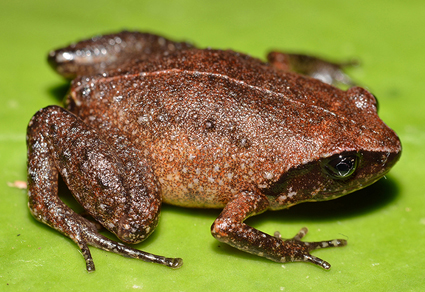Abstract
A new species of the genus Vietnamophryne is described from Vietnam on the basis of two specimens collected from Tuyen Quang Province, Northeastern Vietnam. The new species is morphologically most similar to Vietnamophryne occidentalis from Thailand, however, it differs from the latter by having large black blotches in the lower jaw region, and a yellow-orange chest and belly. The genetic distance between the new species and other Vietnamophryne taxa is > 2.13% (16S mtDNA gene fragment). Vietnamophryne aurantifusca sp. nov. can be distinguished from all other species of Vietnamophryne by a combination of the following morphological characteristics: Size medium (SVL 17.6–18.2 mm in males); head wider than long; tympanum medium; finger I longer than half of finger II; dorsal skin relatively smooth with some round nodules, concentrated in the middle of the back, arranged along the length of the back, with a prominent ridge along the spine; Dorsum orangish-brown entirely and paler on margin of back with a small brownish ridge along the spine; sides brownish with creamy patches and orange spots; ventral surface orange, with grey marbling, most intense on the throat, ventral side of arms and thighs, and ventral surfaces of limbs dark grey with some orange spots.
References
- Frost, D.R. (2023) Amphibian Species of the World: an Online Reference. Version 6.2. American Museum of Natural History, New York. Available from: https://amphibiansoftheworld.amnh.org/index.php (accessed 7 July 2023)
- Hedges, S.B. (1994) Molecular evidence for the origin of birds. Proceedings of the National Academy of Sciences USA, 91, 2621–2624. https://doi.org/10.1073/pnas.91.7.2621
- Higgins, D.G. (1994) CLUSTAL V: multiple alignment of DNA and protein sequences. Methods Molecular Biology, 25, 307–318. https://doi.org/10.1385/0-89603-276-0:307
- Hillis, D.M. & Bull, J.J. (1993) An empirical test of bootstrapping as a method for assessing confidence in phylogenetic analysis. Systematic Biology, 42, 182–192. https://doi.org/10.1093/sysbio/42.2.182
- Hoang, C.V., Jianping, J., Nguyen, H.Q., Orlov, N.L., Le, M.V., Nguyen, H.V., Nguyen, V.T., Nguyen, T.T. & Ziegler, T. (2021) A new species of Vietnamophryne from Vietnam. Revue suisse de Zoologie, 128 (1), 207–219. https://doi.org/10.35929/RSZ.0046
- Huelsenbeck, J.P. & Hillis, D.M. (1993) Success of Phylogenetic Methods in the Four-Taxon Case. Systematic Biology, 42 (3), 247–264. https://doi.org/10.1093/sysbio/42.3.247
- Kumar, S., Stecher, G. & Tamura, K. (2016) MEGA7: Molecular Evolutionary Genetics Analysis version 7.0 for bigger datasets. Molecular Biology and Evolution, 33 (7). https://doi.org.10.1093/molbev/msw054
- Leaché, A.D. & Reeder, T.W. (2002) Molecular systematics of the eastern fence lizard (Sceloporus undulatus): a comparison of parsimony, likelihood, and Bayesian approaches. Systematic Biology, 51, 44–68. https://doi.org/10.1080/106351502753475871
- Nguyen, V.T., Hoang, C.V., Jianping, J., Orlov, N.L., Ninh, H.T., Nguyen, H.Q., Nguyen, T.T. & Ziegler, T. (2021) A new species of Vietnamophryne with an extended description of Vietnamophryne orlovi. Russian Journal of Herpetology, 28 (6), 355–368. https://doi.org/10.30906/1026-2296-2021-28-6-355-368
- Poyarkov, N.A., Suwannapoom, C., Pawangkhanant, P., Aksornneam, A., Duong, V.T., Korost, D.V. & Che, J. (2018) A new genus and three new species of miniaturized microhylid frogs from Indochina (Amphibia: Anura: Microhylidae: Asterophryinae). Zoological Research, 38 (3), 1–26. https://doi.org/10.24272/j.issn.2095-8137.2018.019
- Poyarkov Jr, N.A., Vassilieva, A.B., Orlov, N.L., Galoyan, E.A., Dao, T.T.A., Le, D.T.T., Kretova, V.D. & Geissler, P. (2014) Taxonomy and distribution of narrow-mouth frogs of the genus Microhyla Tschudi, 1838 (Anura: Microhylidae) from Vietnam with descriptions of five new species. Russian Journal of Herpetology, 21 (2), 89–148. https://doi.org/10.30906/1026-2296-2014-21-2-89-148
- Rambaut, A., Drummond, J.A., Xie, D., Baele, G & Suchard, A.M. (2018) Posterior Summarization in Bayesian Phylogenetics Using Tracer 1.7. Systematic Biology, 67 (5), 901–904. https://doi.org/10.1093/sysbio/syy032
- Ronquist, F., Teslenko, M., Mark, P., Ayres, D.L., Darling, A., Höhna, S., Larget, B., Liu, L., Suchard, M.A. & Huelsenbeck, J.P. (2012) MrBayes 3.2: Efficient Bayesian Phylogenetic Inference and Model Choice Across a Large Model Space. Systematic Biology, 61 (3), 539–542. https://doi.org/10.1093/sysbio/sys029
- Scherz, M. D., Schmidt, L., Crottini, A., Miralles, A., Rakotoarison, A., Raselimanana, A., Köhler, J., Glaw, F. & Vences, M. (2021) Into the Chamber of Horrors: A proposal for the resolution of nomenclatural chaos in the Scaphiophryne calcarata complex (Anura: Microhylidae), with a new species-level phylogenetic hypothesis for Scaphiophryninae. Zootaxa, 4938 (3), 392–420. https://doi.org/10.11646/zootaxa.4938.4.2
- Sterling, E.J., Hurley, M.M. & Duc, M.L. (2006) Vietnam: A Natural History. Yale University Press, New Haven and London, 448 pp.
- Suwannapoom, C., Sumontha, M., Tunprasert, J., Ruangsuwan, T., Pawangkhanant, P., Korost, D.V. & Poyarkov, N.A. (2018) A striking new genus and species of cave-dwelling frog (Amphibia: Anura: Microhylidae: Asterophryinae) from Thailand. PeerJ, 6, e4422. https://doi.org/10.7717/peerj.4422
- Tanabe, A.S. (2011) Kakusan 4 and Aminosan: two programs for comparing nonpartitioned, proportional and separate models for combined molecular phylogenetic analyses of multilocus sequence data. Molecular Ecology Resources, 11, 914–921. https://doi.org/10.1111/j.1755-0998.2011.03021.x
- Tavaré, S. (1986) Some probabilistic and statistical problems in the analysis of DNA sequences. Lectures on Mathematics in the Life Sciences, 17, 57–86.
- Tu, N., Yang, M., Liang, D. & Zhang, P. (2018) A large-scale phylogeny of Microhylidae inferred from a combined dataset of 121 genes and 427 taxa. Molecular Phylogenetics and Evolution, 126, 85–91. https://doi.org/10.1016/j.ympev.2018.03.036


